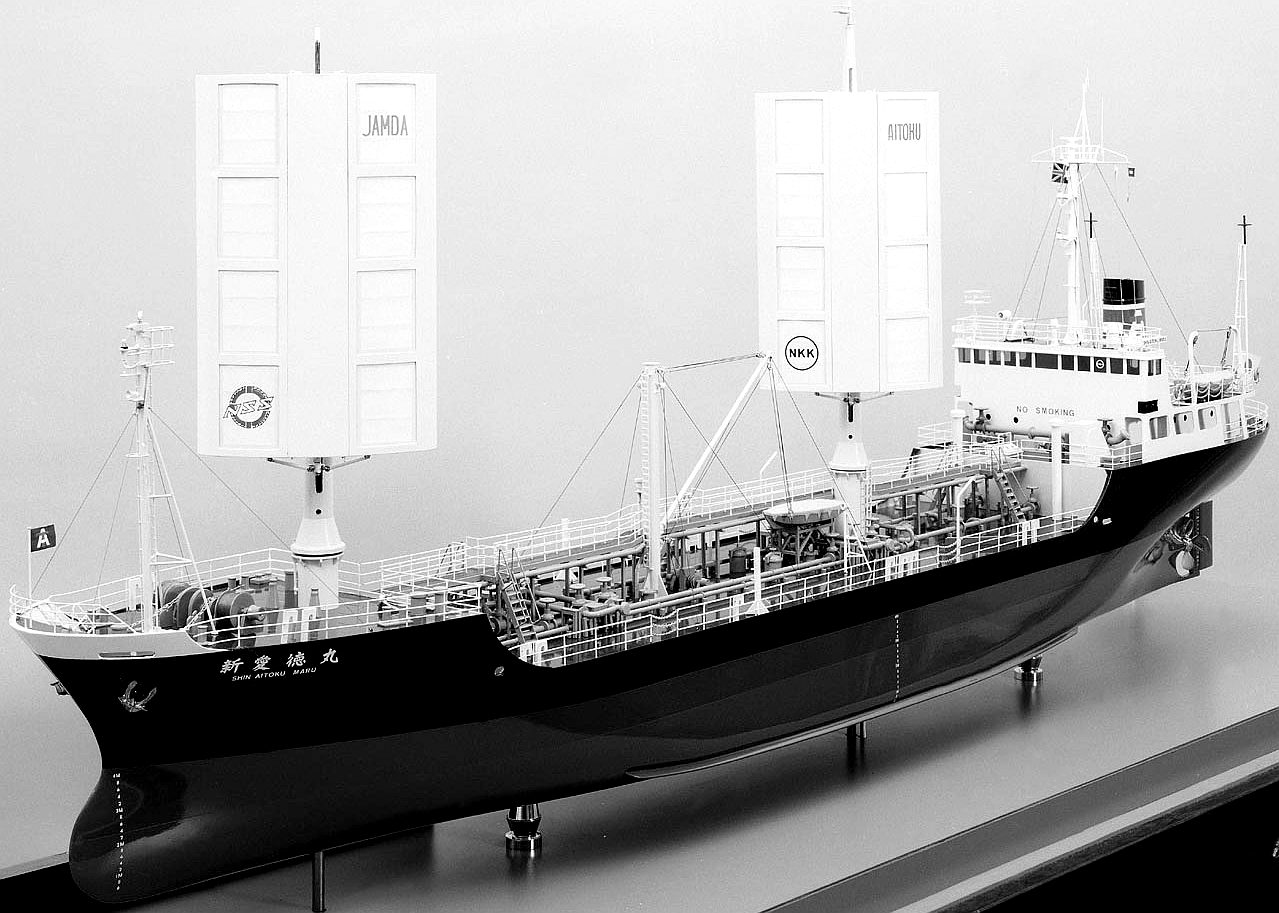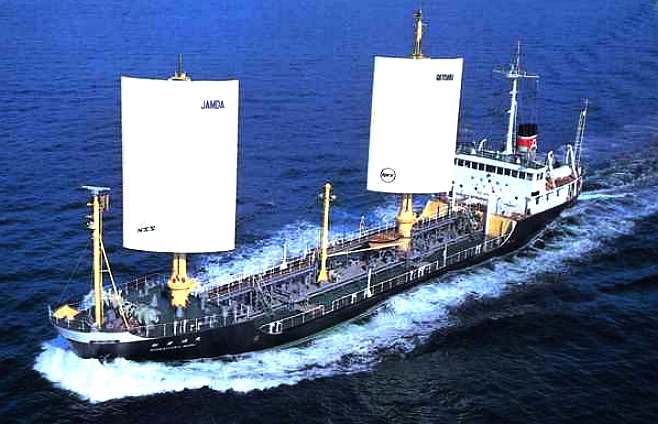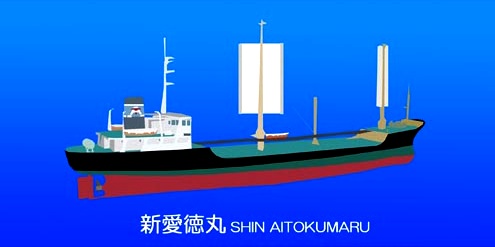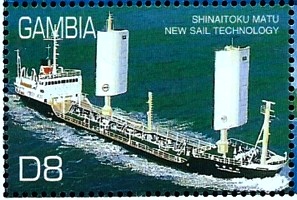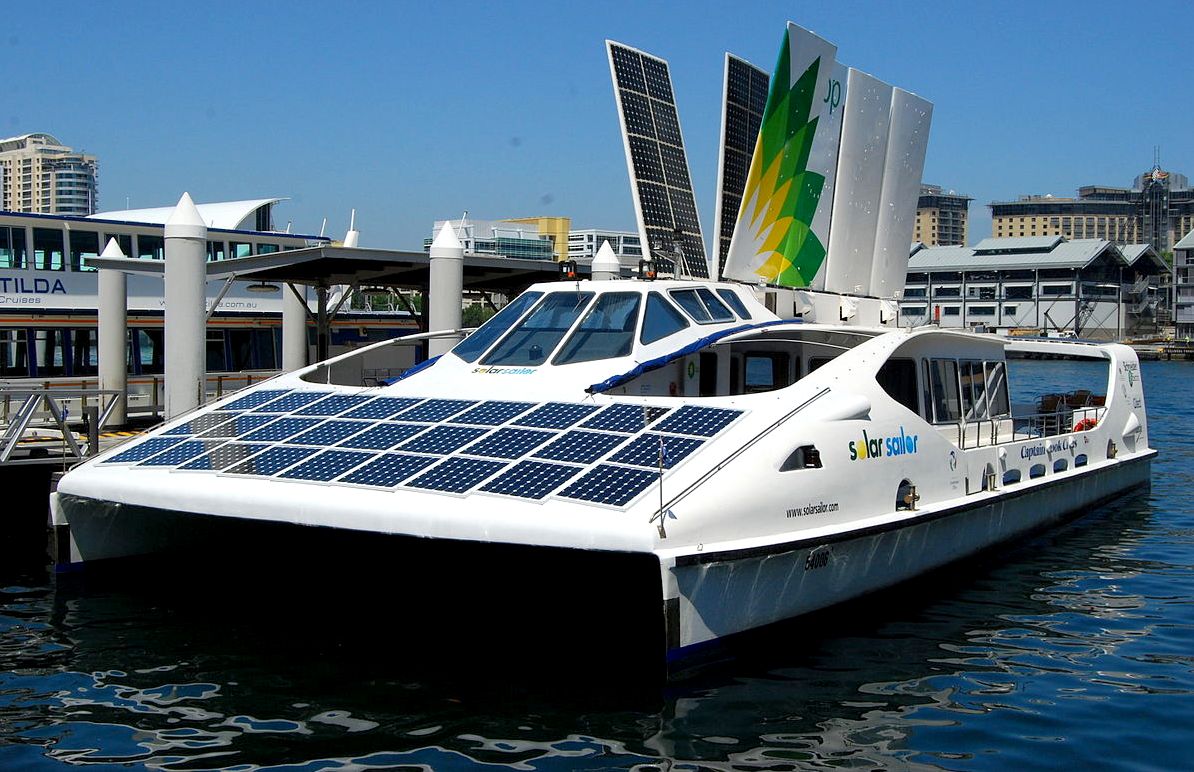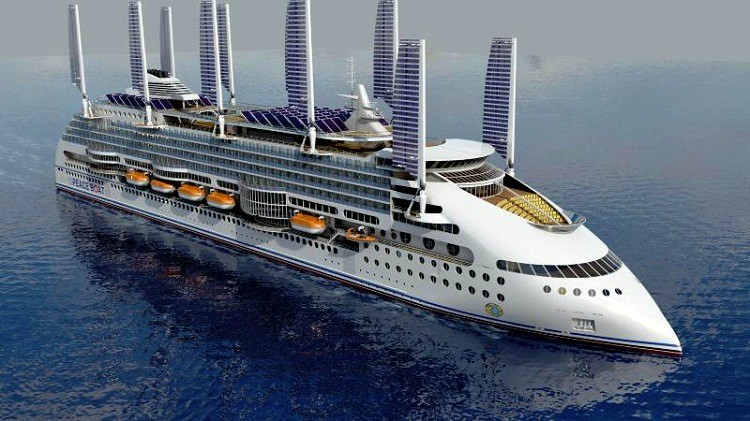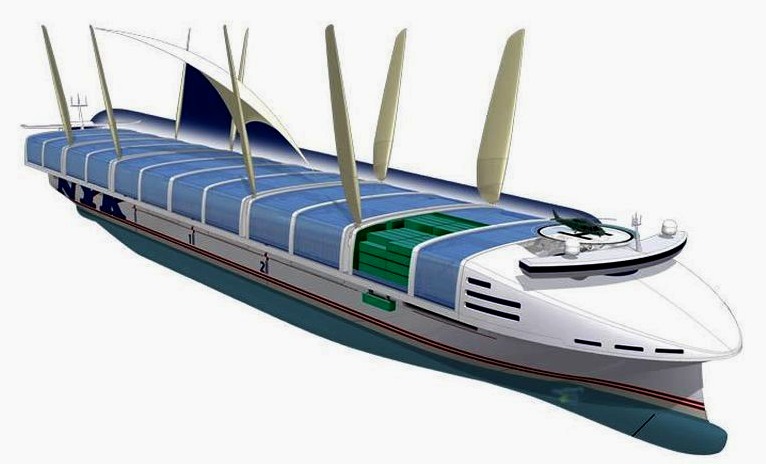|
SHIN AITOKU MARU
Please use our A-Z INDEX to navigate this site where page links may lead to other sites
|
|||||||||||||||||||||||||||||||||||||||||||||||||||||||||||||||||||||||||||||||||||||
|
The revolutionary Japanese sail-assisted tanker, ‘Shin Aitoku Maru’ (1980) was built for use in the Far East as a result of the 1970s oil crisis that saw rationing of petrol and diesel fuels.
The vessel looks like any other plying the Sea of Japan. But in a favourable breeze, an onboard computer unfurls a pair of rectangular canvas sails and sets them to the wind enabling the engine to close down and the ship to operate at speeds of up to 12 knots under wind power alone.
‘Shin Aitoku Maru’ is almost the same size as the ‘Cutty Sark’ but in contrast to the latter’s 2400 square metres of sail, the tanker carries just 200 square metres of canvas stretched taut by rigid metal frames that more resemble windmill paddles than the billowing sails of a clipper. Moreover the sails act as stabilizers, ensuring less pitching and rolling than on a conventional ship.
The ship is environmentally friendly in other areas, too. Sludge is treated onboard with a homogenizer and burnt with fuel oil. Sewage is also treated and burnt. No extra hands are required for this ’sailing ship‘; the ship’s crew is just six in total.
The above picture is of a model that at the flick of a switch, the sails unfurl and slew about the mast, navigation lights flicker to life, the radar revolves, and the propeller rotates. This superb scale replica was presented to HRH The Duke of Edinburgh by the President of the Japanese Marine Machinery Development Association.
20世紀後半に登場した日本の帆船~
Die Shin Aitoku Maru war das erste kommerziell erfolgreiche Motorsegelschiff seit dem Ende der „klassischen“ Segelfrachtschifffahrt. Sie stellt einen Schiffstyp dar, mit dem erneut versucht wurde, bei einem ansonsten herkömmlichen Frachtschiff mit Hilfe einer Segeleinrichtung entweder die Geschwindigkeit zu erhöhen oder den Kraftstoffverbrauch zu reduzieren.
Das Konzept der Shin Aitoku Maru wurde von Nippon Kokan in Zusammenarbeit mit der JAMDA (JApan Machinery Development Association) entwickelt. Sie wurde 1980 von der japanischen Werft Imamura in Kure gebaut. 1990 wurde sie in Nippo Maru umbenannt und fährt seit 1994 unter ihrem heutigen Namen Yue You 129. Weitere 17 Schiffe wurden nach dem Prinzip der Shin Aitoku Maru gebaut, insbesondere 1984 die 26.000 Tonnen tragende Usuki Pioneer und die noch einmal etwas größere Aqua City.
SUSTAINABLE CONTAINER SHIPS - This 50m concept vessel may be doubled and quadrupled without too much trouble. You'd need to up-scale by a factor of 8 to match the 400 meter ships that operate today to carry 960 standard containers. See our top ten list below. That is nowhere near the capacity of a heavy bunker fueled giant, but it is a formula for eventual 100% zero carbon transportation that is theoretically workable. We believe that such a system could eventually replace bunker fuels and eliminate the need for liquid fuels that may be potentially dangerous.
CARGO CONTENDERS A list of the top ten fossil fueled leaders that could benefit from solar and wind assistance. You may notice from the specification of these vessels that we are in the right ballpark for power to cargo ratio when comparing DWT to installed engine power:
The concept of using wind and solar power together on ships is no longer science fiction, nor is it decades away. There are a number of interesting concepts under development. In our view the first practical application of combined wind and solar power was with Solar Sailor, where sails were also solar panels that could be aimed.
A - Z SAIL AND SOLAR ASSISTED BOATS & SHIPS
LINKS & REFERENCES
http://www.sautercarbonoffsetdesign.com/black-magic3.html https://seaportgame.fandom.com/wiki/Save_the_oceans_-_Ships https://www.seatrade-maritime.com/news/americas/new-coalition-to-push-for-zero-carbon-emission-shipping-by-2030/ https://www.mol.co.jp/en/pr/2019/19065.html https://www.j-l-a.com/press_releases/classnk-grants-aip-related-to-wind-challenger-project/ https://shipandbunker.com/news/world/148606-solar-and-wind-powered-cruise-ship-to-sail-in-2020
TRANSFERABLE TECHNOLOGY - The design of the Climate Change Challenger might be adapted to Cargo, Container, Cruise and Ferry designs, without needing to radically alter port facilities. The designs above are not representative of adaptations of the concept, but serve to illustrate the thinking of other design houses.
Please use our A-Z INDEX to navigate this site
AEGEAN - ADRIATIC SEA - ARCTIC OCEAN - ATLANTIC OCEAN - BALTIC SEA - BAY OF BENGAL - BERING SEA - CARIBBEAN SEA - CORAL SEA EAST CHINA SEA - ENGLISH CHANNEL - GULF OF GUINEA - GULF OF MEXICO - INDIAN OCEAN - IONIAN - IRISH SEA - MEDITERRANEAN SEA NORTH SEA - PACIFIC OCEAN - PERSIAN GULF - SEA OF JAPAN - SOUTH CHINA SEA - SOUTHERN OCEAN - TYRRHENIAN
|
|||||||||||||||||||||||||||||||||||||||||||||||||||||||||||||||||||||||||||||||||||||
|
This website is provided on a free basis as a public information service. copyright © Climate Change Trust 2019. Solar Studios, BN271RF, United Kingdom.
|
